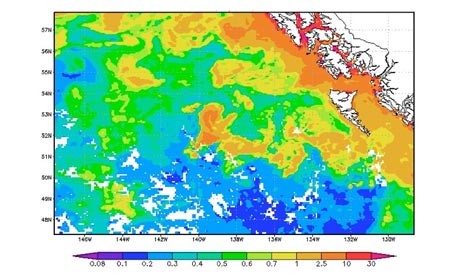World’s biggest geoengineering experiment ‘violates’ UN rules
October 17, 2012

Yellow and brown colors show relatively high concentrations of chlorophyll in August 2012, after iron sulphate was dumped into the Pacific Ocean as part of a controversial geoengineering scheme (credit: Giovanni/Goddard Earth Sciences Data and Information Services Center/NASA)
Controversial U.S. businessman’s iron fertilization off west coast of Canada contravenes two UN conventions.
Russ George, a controversial California businessman, dumped about 100 tons of iron sulphate into the Pacific Ocean as part of a geoengineering scheme off the west coast of Canada in July, a Guardian investigation reveals.
Lawyers, environmentalists and civil society groups are calling it a “blatant violation” of two international moratoria and the news is likely to spark outrage at a United Nations environmental summit taking place in India this week, says The Guardian.
Satellite images appear to confirm the claim by Californian that the iron has spawned an artificial plankton bloom as large as 10,000 square kilometers. The intention is for the plankton to absorb carbon dioxide and then sink to the ocean bed — a geoengineering technique known as ocean fertilization that he hopes will net lucrative carbon credits.
Scientists are debating whether iron fertilization can lock carbon into the deep ocean over the long term, and have raised concerns that it can irreparably harm ocean ecosystems, produce toxic tides and lifeless waters, and worsen ocean acidification and global warming.
International legal experts say George’s project has contravened the UN’s convention on biological diversity (CBD) and London convention on the dumping of wastes at sea, which both prohibit for-profit ocean fertilization activities.